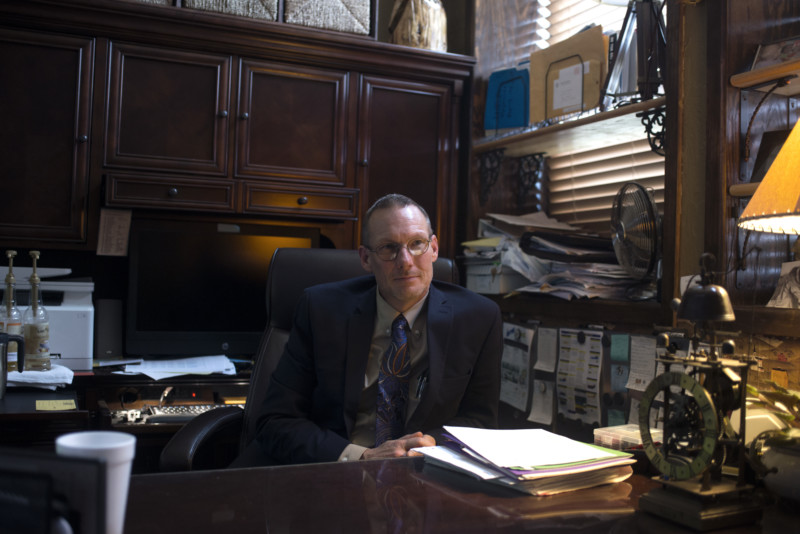Sign up for The Media Today, CJR’s daily newsletter.
A few months before the shooting at Marjory Stoneman Douglas High School in Parkland, Florida, I began to seek out schools in America that planned to arm teachers, or already had. When working in the US, my projects largely focus on Texas—a state with a long and ingrained relationship with firearms, and the birthplace of many of America’s contemporary ideas about arming teachers.
In 2007, after the mass shooting at Virginia Tech, David Thweatt, superintendent of Harrold Independent School District in North Texas, began quietly encouraging his teachers to keep handguns in the classroom. “We flew under the radar for about a year,” says Thweatt. Working with his school board and a team of lawyers, Thweatt created the Guardian Plan, which legalized the carrying of pistols by teachers. “The names of our Guardians are kept confidential,” Thweatt wrote in The Washington Post earlier this year, “and they are paid a small yearly stipend in addition to their regular salaries to have them carry concealed handguns at school.”

Superintendent David Thweatt of Harrold Independent School District, near Wichita Falls, Texas, which serves just over 100 students. Thweatt: “‘Guns and children don’t mix’: that is the aphorism they love to say. But guns mix with everything and always have. It’s just a tool. That is like saying hammers and kids don’t mix; well, they don’t if you’re aiming it at their thumbs.” Photo by Spike Johnson.
Thweatt’s Guardian Plan became more popular following the Sandy Hook Elementary School shooting, appealing to the boards of some rural schools, which can be far from law enforcement and may lack funds for dedicated security personnel. Still, at the time, there was nothing like the current levels of political support for training teachers as first responders to active-shooter incidents. After the Parkland shooting, President Trump voiced support for arming school teachers. Following the fatal May shooting at Santa Fe High School, Texas Governor Greg Abbott released a proposal to arm more school staff in his state.
Pulling off my photography project has been tough. Most schools I’ve reached out to have been wary of meeting me, afraid of participating in coverage of such a charged topic. Teachers I met with were bound by the anonymity clauses in the same laws that permit them to possess guns on campus; they couldn’t tell me which weapons they used, what caliber bullet, who exactly had weapons, or how many staff members were armed.
Under the Guardian Plan, schools are free to set their own rules around training hours, weapon choice, and level of anonymity among guardians. All of the subjects depicted in my series carry firearms, and chose to speak openly with me.
My subjects all shared similar motivations: a desire to protect the children in their care, and a frustration at the lack of other alternatives for them. Handguns—carried under the Guardian Plan or the School Marshal Program, both of which include training and licensing regulations—represent for them an affordable and possible solution.
For many of the individuals I’ve worked with, politics seemed less of a motivating factor than more primal needs —a desire for protection, or to match a perceived threat. “Do I like being in a situation where we have to even consider being guardians of our kids, that the world has come to this? Absolutely not,” Jeff Harvey, superintendent of Texas’ Fayetteville Independent School District, told me during an interview. “It’s a disgrace that humanity is at this level. But I also know that I am going to treat these kids like they are my own. And that means we are going to protect them like they are our own.”

Superintendent Jeff Harvey at Fayetteville Independent School District, near La Grange, Texas. Fayetteville ISD implemented the Guardian Plan in 2018, and serves around 250 students. Photo by Spike Johnson.

Chief Ronny Potts at Keene Independent School District, near Dallas, Texas. Keene ISD implemented the Guardian Plan in 2015, and serves just over 1,000 students. Potts: “Our ultimate goal is to make the school a harder target for anyone who may pull in off the highway. This school district is like a family. We don’t have bad problems; we have good kids we want to protect.” Photo by Spike Johnson.

Superintendent Dr. Telena Wright at Argyle Independent School District, near Dallas, Texas. Argyle ISD implemented the Guardian Plan in 2014, and serves nearly 2,000 students. Wright: “Extreme concern was voiced after Sandy Hook, when one of the school district board members stepped forward and said: “I don’t believe I could go to 20 funerals and look those parents in the eye unless I could answer the question, ‘Did you do everything you possibly could to protect my child?’” Photo by Spike Johnson.

Holliday Independent School District, near Wichita Falls, Texas. Holliday ISD implemented the Guardian Plan in 2013 and serves nearly 1,000 students. Photo by Spike Johnson.
Has America ever needed a media defender more than now? Help us by joining CJR today.



